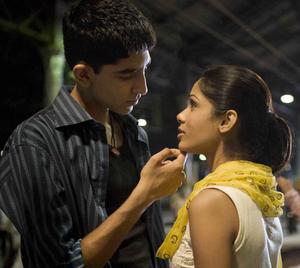

The movie tells the story of Jamal, a young man who finds his way out of the violence and squalor of Mumbai, India's worst slums.
It's the latest "little film that could." The British/Indian co-production Slumdog Millionaire has received a great deal of popular attention and seen a meteoric rise from small festival indie to award-season favorite.
The movie tells the story of Jamal, a young man who finds his way out of the violence and squalor of Mumbai's worst slums and on to the Indian version of the television show Who Wants to Be a Millionaire. He's there to compete for the grand prize and a chance at a better life for the girl he loves.
To date, the movie has won top honors at the Golden Globes and the BAFTAs (British Academy of Film & Television Awards) and has been nominated for 11 Oscars this year, including Best Picture. Cynical film critics and morning TV hosts alike have encouraged the movie-going public to experience it for themselves.
What might account for the film's surprising appeal, especially in America? After all, Slumdog contains brutal, heartbreaking depictions of third-world shanty towns and the pitiable children who inhabit them. Its characters speak heavily-accented English or Hindi slang (subtitles provided). Its plot is constructed in a busy, non-linear fashion. Such characteristics rarely appeal to an American viewing audience accustomed to special effects, simple plots, and brevity (Slumdog clocks in at two solid hours, while most Hollywood blockbusters barely make it to 90 minutes).
It's not even a close kin to the usual "Bollywood" fare of dreamy song- and dance-filled pop fantasies.
Film reviewers suggest that the movie succeeds here because of its recognizable storyline: a young man rises out of poverty with his wits and his perseverance, finding love, money, and fame along the way. In a sense, they are right: the film does evoke memories of other rags to riches tales like Rocky or A Coalminer's Daughter. After all, what's more American than a story of a boy following his own manifest destiny? While that may capture some of the reason behind the appeal of Slumdog, it's insufficient to explain why this particular film, with its deep portrayal of greed and tragedy -- of ugliness and prejudice--stands out from the yearly onslaught of feel-good flicks like The Pursuit of Happyness, The Great Debaters, or Freedom Writers.
I think the universal allure of Slumdog Millionaire is a testament to the style of its director, Danny Boyle. Boyle is a well-respected English filmmaker who has helmed features like Trainspotting, The Beach, and 28 Days Later plus lesser-known beauties like Millions and the sci-fi thriller Sunshine.
Americans are perhaps most familiar with the frenetic, suggestive, and terrifying suspense of the zombie flick 28 Days Later. Visually, Boyle achieves much the same in Slumdog. Granted, the subject matter of the two differs vastly, but in both films Boyle makes the audience a part of the action on-screen. He places the camera over the shoulders, under the legs, and through the eyes of his characters. We experience the sweat, the panic, and the longing of lives lived on the edge.
We sense in these films that so very much is at stake; we become invested in the fate of the characters. We feel ourselves as participants in an oddly feasible reality -- the last survivors seeking safety in post-apocalyptic London or the desperate youths being chased through the crowded streets of Mumbai. It is not the story per se that grabs us; it is the moment, the impression, and the emotion conveyed in purely cinematic language. Boyle has become a master of this language, and the effect is exhilarating and universal.
If you see the film, you'll leave the theater with a definite sense of satisfaction and even joy, but Slumdog hardly suggests that all is right with the world. What you'll remember most is a sequence of visual gut-punches: unimaginable poverty. Heat-saturated landscapes. The faces of dirty children. Unconscionable villainy. Faith-reviving sacrifice. Just watch; you'll see.
About the Reviewer: Mark Dollar is Associate Professor of English, King College, Bristol, Tenn.